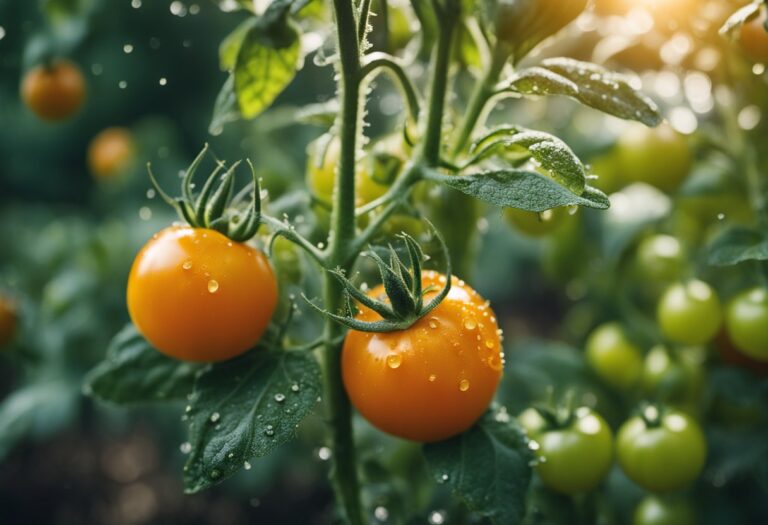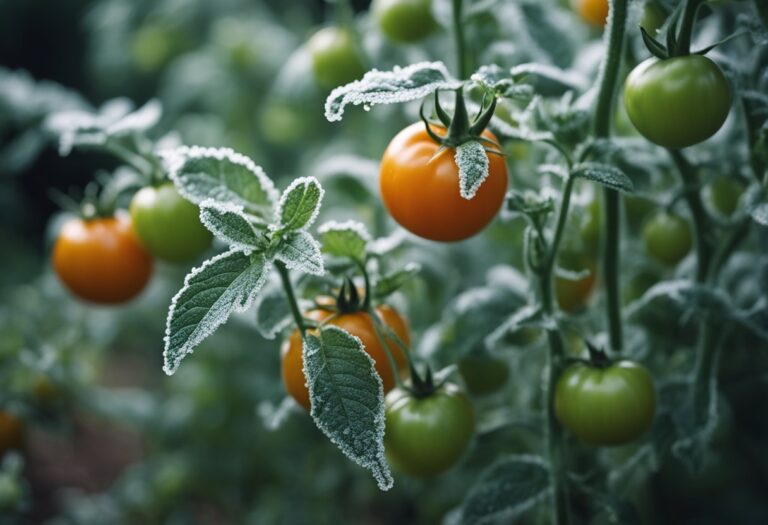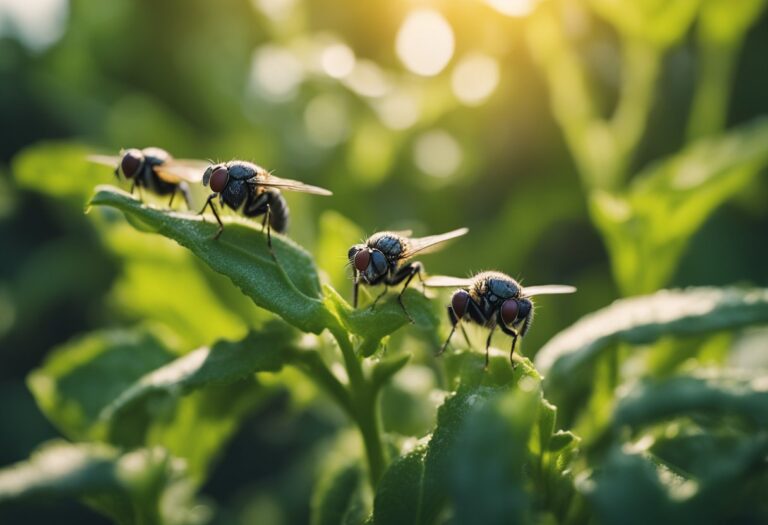Why Do Cherry Tomatoes Split After Picking: Understanding the Causes
Have you ever gone out to your garden to pick some fresh cherry tomatoes, only to find that some of them have split open? It can be frustrating to see your hard work go to waste, but don’t worry, there are ways to prevent this from happening.
In this article, we will explore why cherry tomatoes split after picking and what you can do to prevent it from happening.
Tomato splitting is a common problem that many gardeners face. It occurs when the tomato skin can no longer keep up with the growth of the fruit, causing it to split open.
There are several factors that can contribute to tomato splitting, including irregular watering, rapid fruit growth, and certain environmental circumstances. Understanding these factors is essential to avoiding cherry tomato splitting and ensuring a plentiful crop.
By learning the science behind tomato splitting and the factors that influence it, you can take steps to prevent it from happening in your garden.
From proper watering techniques to the role of climate in tomato splitting, we will cover everything you need to know to keep your cherry tomatoes intact and delicious. So let’s dive in and explore the world of cherry tomato splitting.
Key Takeaways
- Cherry tomatoes split open due to a variety of causes, including irregular watering, rapid fruit growth, and certain environmental circumstances.
- Understanding the science behind tomato splitting and the factors that influence it is essential to preventing it from happening in your garden.
- Proper watering techniques, soil management, and climate control can all play a role in preventing cherry tomato splitting.
Why Do Cherry Tomatoes Split After Picking?
Cherry tomatoes are a delicious and healthy addition to any meal. They are easy to grow and provide a bountiful harvest. However, sometimes cherry tomatoes split after picking, which can be frustrating for gardeners. There are several reasons why cherry tomatoes split after picking, including:
- Irregular watering: Cherry tomatoes require consistent watering to prevent splitting. If the soil is too dry, the tomatoes will absorb water quickly, causing them to split. On the other hand, if the soil is too wet, the tomatoes will absorb too much water, causing them to burst.
- Rapid fruit growth: Cherry tomatoes grow quickly, and if they grow too fast, the skin may not be able to keep up with the growth, causing it to split.
- Temperature fluctuation: If the temperature changes rapidly, it can cause the tomatoes to split. For example, if the temperature drops at night, the tomatoes may not be able to adjust to the change, causing them to split.
- Exposure to high heat and humidity: If the tomatoes are exposed to high heat and humidity, it can cause them to split. This is because the skin of the tomato becomes weak and cannot hold the fruit together.
- Variety: Some varieties of cherry tomatoes are more prone to splitting than others. If you are experiencing a lot of splitting, consider trying a different variety.
Now that you know why cherry tomatoes split after picking, you can take steps to prevent it from happening. Here are some tips to help you prevent cherry tomatoes from splitting:
- Water consistently: Water your cherry tomato plants regularly to prevent the soil from becoming too dry or too wet.
- Harvest early: Harvest your cherry tomatoes as soon as they are ripe to prevent them from splitting on the vine.
- Provide shade: If your cherry tomatoes are exposed to high heat and humidity, provide them with some shade to protect them from the sun.
- Choose the right variety: If you are experiencing a lot of splitting, try growing a different variety of cherry tomato that is less prone to splitting.
By following these tips, you can enjoy a bountiful harvest of cherry tomatoes without having to worry about them splitting after picking.
The Science Behind Tomato Splitting
Have you ever picked a cherry tomato from your garden only to find it has split open? This can be frustrating, especially if you were planning on using it in a recipe or sharing it with friends. But why do cherry tomatoes split after picking?
Tomatoes split due to changes in moisture levels. When a tomato plant receives inconsistent watering, the fruit may grow too quickly, causing the skin to crack. This is especially common in cherry tomatoes, which have thin skin compared to larger tomato varieties.
Another factor that can contribute to tomato splitting is temperature fluctuations. If the temperature changes rapidly, the fruit may expand and contract, causing the skin to crack.
Interestingly, certain environmental circumstances can also cause cherry tomatoes to split after harvest. For example, if the humidity is too high, the fruit may absorb too much moisture, causing it to split. Additionally, if the tomato plant receives too much nitrogen, the fruit may grow too quickly, leading to splitting.
To prevent cherry tomatoes from splitting after picking, it is important to maintain consistent moisture levels in the soil. This means watering your tomato plants regularly and ensuring they receive adequate drainage. Additionally, you can harvest your cherry tomatoes as soon as they ripen to prevent them from becoming overripe on the vine.
Factors That Influence Tomato Splitting
There are several factors that can contribute to cherry tomatoes splitting after picking.
Understanding these factors can help you prevent splitting and maintain the quality of your tomatoes for longer. Here are some of the most important factors to keep in mind:
1. Stage of Ripeness
The stage of ripeness can influence a cherry tomato’s proneness to splitting. Tomatoes that are not fully ripe are more likely to split than those that are fully ripe. This is because the skin of a ripe tomato is thicker and more elastic, making it less likely to burst under pressure.
2. Inconsistent Watering
Inconsistent watering is one of the most common causes of cherry tomato splitting.
When a tomato plant goes through periods of drought followed by heavy watering, the tomatoes will absorb water rapidly, leading to quick expansion and eventual splitting. To prevent this, make sure to water your tomato plants regularly and evenly.
3. Rapid Fruit Growth
Rapid fruit growth can also cause cherry tomatoes to split. When a tomato plant produces fruit too quickly, the skins may not have enough time to develop properly, causing them to split under pressure.
To prevent this, make sure to prune your tomato plants regularly and remove any excess fruit that may be hindering proper growth.
4. Environmental Conditions
Certain environmental conditions can also contribute to cherry tomato splitting. For example, high temperatures and humidity can cause the skins of the tomatoes to weaken, making them more prone to splitting.
To prevent this, make sure to provide adequate ventilation for your tomato plants and avoid exposing them to extreme temperatures.
By keeping these factors in mind, you can help prevent cherry tomato splitting and ensure that your tomatoes stay fresh and delicious for longer.
Preventing Tomato Splitting
If you’re growing cherry tomatoes, you may have noticed that they tend to split after picking.
This can be frustrating, especially if you’ve put in a lot of effort to grow your own produce. Fortunately, there are steps you can take to prevent cherry tomatoes from splitting.
Harvesting Techniques
One of the most important things you can do to prevent cherry tomatoes from splitting is to harvest them at the right time. If you wait too long, the tomatoes will become overripe and more likely to split. On the other hand, if you harvest them too early, they may not be as flavorful.
To determine when your cherry tomatoes are ready to be picked, look for signs of ripeness. The tomatoes should be firm and have a bright, consistent color. If they’re still green or have any white or yellow areas, they’re not ready yet.
When you’re ready to harvest your cherry tomatoes, use a pair of sharp scissors or pruning shears to cut the stem that connects the tomato to the plant. This will help prevent damage to the tomato and reduce the risk of splitting.
Watering Practices
Another factor that can contribute to cherry tomato splitting is inconsistent watering. If the soil around your tomato plants dries out too much, the tomatoes may become stressed and more likely to split.
To prevent this from happening, make sure to water your tomato plants regularly and deeply. Aim to provide about 1-2 inches of water per week, depending on the weather and soil conditions. If you’re growing cherry tomatoes in containers, you may need to water them more frequently.
It’s also a good idea to mulch around your tomato plants to help retain moisture in the soil. This can help reduce the risk of water stress and splitting.
By using proper harvesting techniques and watering practices, you can help prevent cherry tomatoes from splitting after picking. This will allow you to enjoy your homegrown produce to the fullest and avoid the frustration of dealing with split tomatoes.
The Role of Climate in Tomato Splitting
The climate is one of the main factors that can cause cherry tomatoes to split after picking. Temperature and humidity changes can stress the fruit, which can lead to splitting. Here are some ways that climate can affect cherry tomato splitting:
- Hot and Dry Weather: If the weather is hot and dry, tomatoes may split due to the heat. When the fruit is exposed to high temperatures, it can cause the skin to expand rapidly, leading to splitting.
- Sudden Rains: Sudden heavy rains can also cause cherry tomatoes to split. When the soil around the plant absorbs a large amount of water, the fruit may take in more moisture than it can handle, which can cause the skin to burst.
- Humidity Changes: Changes in humidity can also cause cherry tomatoes to split. When the humidity is low, the fruit may lose moisture, which can cause the skin to dry out and split. On the other hand, when humidity is high, the fruit may absorb too much moisture, which can cause the skin to expand and burst.
To prevent cherry tomatoes from splitting due to climate factors, here are some tips:
- Provide Consistent Watering: To prevent cherry tomatoes from splitting due to sudden changes in moisture levels, it’s important to provide consistent watering. A plant in the ground requires 1-2 inches of water per week, whereas a plant in a pot requires 1-2 tablespoons per week.
- Provide Shade: If the weather is hot and dry, providing shade for the plants can help to prevent cherry tomatoes from splitting. You can use shade cloth or plant the tomatoes in a location that receives partial shade.
- Cover Plants During Heavy Rains: If you know that heavy rains are coming, you can cover the plants with a tarp or plastic sheeting to prevent the fruit from absorbing too much moisture.
- Harvest Early: To prevent cherry tomatoes from splitting due to overripening on the vine, it’s best to harvest them when they are still slightly underripe. You can then let them ripen fully indoors.
By taking these steps, you can help to prevent cherry tomatoes from splitting due to climate factors, ensuring that you have a bountiful harvest of delicious, unblemished fruit.
Frequently Asked Questions
Can cherry tomatoes still be eaten if they split?
Yes, split cherry tomatoes can still be eaten. However, they may not look as appealing and could spoil more quickly. If you plan to use them for cooking, it’s best to use them as soon as possible.
Why do tomatoes crack on top and bottom?
Tomatoes crack on top and bottom when there is a sudden change in moisture levels. This change causes the tomato to grow too quickly, and the skin can’t keep up with the growth.
This can happen when there is too much rain or when the soil dries out and is then watered heavily.
What causes cherry tomatoes to split after picking?
Cherry tomatoes split after picking when there is a fluctuation in temperature. When the temperature changes, the ripening speed of the tomato can be affected, and this can cause splits. Inconsistent watering can also cause splitting.
Is overwatering the reason cherry tomatoes split?
Overwatering can contribute to cherry tomatoes splitting. When the soil is left to dry out and is then overwatered, the tomato’s skin can’t keep up with the growth, and it splits. It’s important to water consistently and not let the soil dry out too much.
How can I prevent cherry tomatoes from splitting?
To prevent cherry tomatoes from splitting, you can:
- Water consistently and avoid letting the soil dry out too much.
- Harvest at the right time when the tomatoes are fully ripe.
- Provide shade and protection from extreme temperatures.
- Improve soil quality by adding compost or organic matter.
- Prune the plant to reduce stress on the tomato.
- Use mulch to help retain moisture in the soil.
Are split cherry tomatoes safe to eat?
Yes, split cherry tomatoes are safe to eat. However, they may spoil more quickly and may not look as appealing. If you plan to use them for cooking, it’s best to use them as soon as possible.



